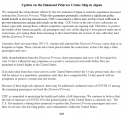2/18 WHO Daily Presser notes Part 1 of 2
Dr. Tetras – Today I want to talk first about Syria vs. COVID. Out of 550 facilities, only ½ are operational. Attacks on the hospitals are against international law.…(more) …. Back to COVID
72,528 cases, 1,850 deaths. In past 24 1,800 new cases. Outside China, now 804 cases in 24 countries with 3 deaths. 110 new cases outside China, 99 on Princess. 92 cases outside China of human to human transmission. We don’t have enough cases outside China to discuss severity or fatality rates. To date, we have not seen localized sustained transmission (e.d. to be able to call it a pandemic) except like Princess. I spoke with Singapore yesterday, and please with their efforts to find every transmission, and they have not found any evidence of community transmission. I also talked to Malesia health director about Westerdam and reparations. This signals for all countries to be ready for the arrival of the virus. Many countries are preparing, we have shipped PPE to 21 countries, and 106 in coming weeks. By the end of the week, 40 countries in Africa and 21 in the Americas will have the ability to detect the virus, vs. sending to other countries to prevent global crisis.
Q&A
Re Princess transmission, how possible the spread we have seen? The situation has evolved, and authorities in Japan revisiting the original decision to group and isolate… situation has changed, there is more transmission on the ship than we expected. Japan is adjusting to that reality now, and Japan officials are now working with other countries to evacuate and deal with follow-up in a different way. Its easy to look back and say it should have been done in a different way. It’s clear that there are some environments where the virus can spread, and cruise ships and other particular environments that disease can spread. Unfortunate event and we trust that the countries and the Japanese will follow up in the appropriate way to get care or reintegrated into the community. It will be very important to study this particular event to see what the issues are that led to transmission on the ship.
Re recent measures of Beijing under quarantine? Currently evaluations are based on modeling. We look at the scenario if nothing was done (e.d. those pessimistic numbers we have seen on those threads, that’s what these are..a baseline). Models have shown that movement restriction has delayed by 2 or 3 days in China and 2-3 weeks outside of China. So based on this, if those measures are implemented.. delays the peak and give more time to treat the problem. We are finding in some studies that it’s 19 days from symptoms to when people are completely cleared of the virus.
You mentioned that some countries outside of China are not providing you data, what’s the reason behind that? Also, the modelling that you are doing, is that modelling from China or outside China? We fully recognize that all countries are under duress and their primary responsibility is to their own citizens and to do the public health challenge that they face. We ask that they do share with us the core data that we need. And I would say that it hasn’t been smooth sailing with any country so far because we’ve had to request a number of countries to speed up their data sharing. This is not due to a lack of transparency but this has been through the urgency and the difficulties of gathering data, collating data and then sharing it outside a country. And in some cases they are data protection issues, privacy issues with long lists that are individualized data, and logistic issues. We are very pleased in general. We do want to see more and more data on community studies, hospital and transmission info like on the Princess and we want to see those investigations early so that we can learn and manage in other circumstances in the coming days and weeks to help us as a global agency to give the best possible advice and evidence to countries.
Answer cont’d/he changed subject.. And to touch back on Beijing, I think if you look at what’s happening in Wuhan the government has spent a number of weeks suppressing the virus and you saw the numbers dropped away and now they have engaged in door to door surveillance – this is a very good public health practice. We like to see progressive implementation of public health measures. So the first objective in Wuhan was to contain the virus at the epicenter and do much more active surveillance. While doing that surveillance they don’t want the virus returning to other places. Beijing is the central point in the country for a place where many many workers return to. While they are putting out the fire in one place, they don’t want the fire to start somewhere else. So they are taking very directed measures to ensure the people returning to Beijing are observed and monitored. You can argue whether those measures are excessive or restrictive, but there’s a lot at stake here in terms of public health not only in China, but of all people of the world. So what we like to see is well thought out, evidence base public health measures that pays respect to individuals liberty and human rights And finding that balance is sometimes difficult. Right now, the strategic and tactical approach in China is the right one, as is the approach in Singapore. Right now we are seeing more and more countries are having well planned and directed operations to detect this virus, contain it, and slow it down. We want all countries to take that approach in the coming days and weeks.
A – the modelling, that is not from the WHO, is that is coming from expert network we have and we meet on a weekly basis with a number of modelling groups across the world and those groups are publishing their data and we have some preprint articles (e.d. like has been posted here at WS) Just note of caution that modelling is based on assumptions, and modelling is better when you have more data into the model. So soon we will have more robust modelling….
DANG IT! I hit wrong button and it has ended, so I don’t have closed captions to help me transcribe anymore.. waiting for it to be reuploaded to continue.
I’m nominating Dr Tedros Ghebreyseus for a Nobel Peace Prize for 2020.



